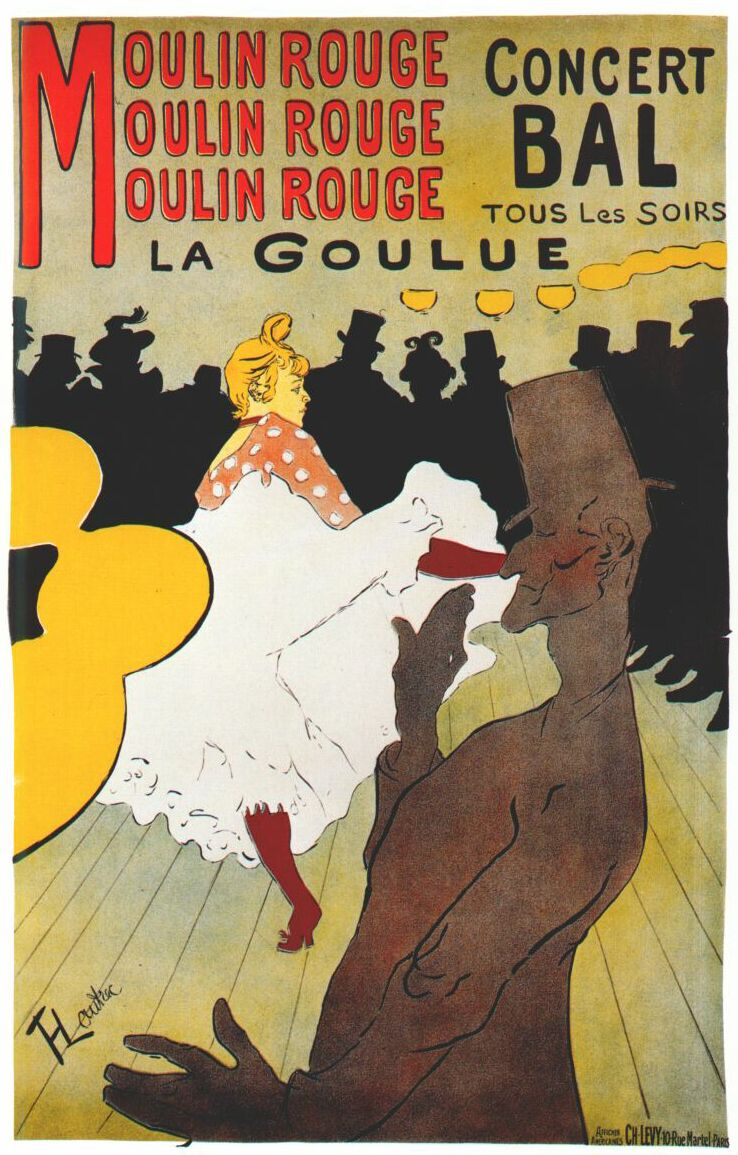log in
Enter site
Login to use Arthive functionality to the maximum
Moulin Rouge-La Goulue
Henri de Toulouse-Lautrec • Pittura, 1891, 189.9×116.5 cm
Descrizione del quadro «Moulin Rouge-La Goulue»
The Moulin Rouge dance hall opened in Montmartre in 1889, and Toulouse-Lautrec was a regular from the beginning. For his first poster - and for the first time in poster painting - he introduced real artists in advertising. This is La Goulou ("The Insatiable"), dancing the cancan with her partner Valentin Beskostny.
In the autumn of 1891, no one could have imagined that this one-day poster would become a collector's item within days, within weeks the subject of press reviews, within months the neighbor of paintings at avant-garde exhibitions, and within a year the internationally recognized symbol of Paris in the 1890s. The poster's circulation was supposedly 3,000 copies. Most are lost, but the surviving ones are in the collections of the Indianapolis Museum of Art and other status institutions.
In the center of the stage on the brightly lit dance floor of the Moulin Rouge, La Goulou is up her skirts in her scandalous dance. Her lanky partner Valentin Boneless is silhouetted in the foreground. This man (real name: Jules Etienne Edm Renodin) was nicknamed le Désossé because of his Ehlers-Danlos syndrome, which allows him to move as if his body had no bones. He was a wine merchant and danced at the Moulin Rouge for free, just for fun.
Toulouse-Lautrec was commissioned to make the poster thanks to his friendship with Moulin Rouge co-founder Charles Siedler, and not because of his talents as a commercial artist - he had never made posters before. But a professional poster artist Jules Schererthe artist, who was initially approached, presented a relatively modest version, which did not satisfy the owners of the club. And Toulouse-Lautrec, who was his devoted admirer and was friends with many performers, made interesting cartoon sketches. He was well suited to create a bold, original poster that maximized the noisy atmosphere of the place with a minimum of elements.
Toulouse-Lautrec has adopted "Japanese style," which was then coming into fashion in Europe. All the silhouettes in this four-color lithograph are simplified, and the triple repetition of the club's name draws attention to the central figure, La Goule. The middle of the poster is simply a fragment of white paper, which the artist has turned into the dancer's petticoats and pantaloons with a few strokes. It is the embodiment of Toulouse-Lautrec's bold, simplistic style, in stark contrast to the heavy, overstuffed posters of the time.
"This Lautrec is nervous as hell and makes no mistakes. No half-measures in the way he draws or the way he paints. Big flat areas of white, black and red-all shapes simplified-and that's all there is to it. He's reduced them to one black slit, these old capitalist knuckleheads sitting at tables with clever little whores licking their faces for more money... It's amazing how he does it with unabashed humor," Vivien Green, a curator from the Guggenheim Museum, remarked in 2017.
In the autumn of 1891, no one could have imagined that this one-day poster would become a collector's item within days, within weeks the subject of press reviews, within months the neighbor of paintings at avant-garde exhibitions, and within a year the internationally recognized symbol of Paris in the 1890s. The poster's circulation was supposedly 3,000 copies. Most are lost, but the surviving ones are in the collections of the Indianapolis Museum of Art and other status institutions.
In the center of the stage on the brightly lit dance floor of the Moulin Rouge, La Goulou is up her skirts in her scandalous dance. Her lanky partner Valentin Boneless is silhouetted in the foreground. This man (real name: Jules Etienne Edm Renodin) was nicknamed le Désossé because of his Ehlers-Danlos syndrome, which allows him to move as if his body had no bones. He was a wine merchant and danced at the Moulin Rouge for free, just for fun.
Toulouse-Lautrec was commissioned to make the poster thanks to his friendship with Moulin Rouge co-founder Charles Siedler, and not because of his talents as a commercial artist - he had never made posters before. But a professional poster artist Jules Schererthe artist, who was initially approached, presented a relatively modest version, which did not satisfy the owners of the club. And Toulouse-Lautrec, who was his devoted admirer and was friends with many performers, made interesting cartoon sketches. He was well suited to create a bold, original poster that maximized the noisy atmosphere of the place with a minimum of elements.
Toulouse-Lautrec has adopted "Japanese style," which was then coming into fashion in Europe. All the silhouettes in this four-color lithograph are simplified, and the triple repetition of the club's name draws attention to the central figure, La Goule. The middle of the poster is simply a fragment of white paper, which the artist has turned into the dancer's petticoats and pantaloons with a few strokes. It is the embodiment of Toulouse-Lautrec's bold, simplistic style, in stark contrast to the heavy, overstuffed posters of the time.
"This Lautrec is nervous as hell and makes no mistakes. No half-measures in the way he draws or the way he paints. Big flat areas of white, black and red-all shapes simplified-and that's all there is to it. He's reduced them to one black slit, these old capitalist knuckleheads sitting at tables with clever little whores licking their faces for more money... It's amazing how he does it with unabashed humor," Vivien Green, a curator from the Guggenheim Museum, remarked in 2017.


